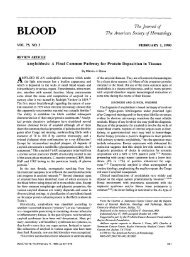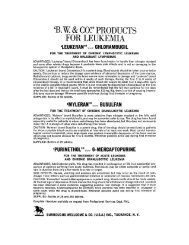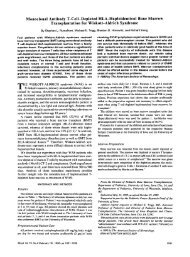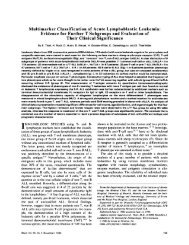Platelet Life Span in Normal, Splenectomized and ... - Blood
Platelet Life Span in Normal, Splenectomized and ... - Blood
Platelet Life Span in Normal, Splenectomized and ... - Blood
You also want an ePaper? Increase the reach of your titles
YUMPU automatically turns print PDFs into web optimized ePapers that Google loves.
From www.bloodjournal.org by guest on April 28, 2015. For personal use only.<br />
48 HJORT AND PAPUTCHIS<br />
.<br />
01<br />
8 tO 2<br />
Days After Injection<br />
FIG. 1.-<strong>Platelet</strong> ratlioactivity after <strong>in</strong>jection of I)FP:5 <strong>in</strong> norusal <strong>and</strong> splenectomized rats.<br />
The same data are plotted on regular paper ( left ) anti on semilogarithmic paper ( right).<br />
Each po<strong>in</strong>t represents one rat; #{149} = nornial rats, <strong>and</strong> X = splenectomized rats. The open<br />
circles give the average for the four daily determ<strong>in</strong>ations.<br />
the two l<strong>in</strong>es ( P = 0.17 ), suggest<strong>in</strong>g that the platelet life span is the same<br />
ifl both groups.<br />
DISCUSSION<br />
The disappearance curve for labeled platelets is most often reported as a<br />
straight l<strong>in</strong>e, suggest<strong>in</strong>g a disappearance by senescence.5 However, some<br />
workers f<strong>in</strong>d an exponential curve, suggest<strong>in</strong>g a r<strong>and</strong>om destruction.’2<br />
Figure 1 shows that our data do not exactly fit either of these two types,<br />
s<strong>in</strong>ce the curves level off at an activity equal to 10 to 20 per cent of the 24<br />
hour value. Other workers6’3 also mention such residual activity. This might<br />
i)e expla<strong>in</strong>ed either by contam<strong>in</strong>ation, or by a prolonged period of label<strong>in</strong>g.<br />
The residual activity is not due to contam<strong>in</strong>ation with plasma, s<strong>in</strong>ce plasma<br />
is virtually <strong>in</strong>active eight days after the <strong>in</strong>jection; <strong>and</strong> contam<strong>in</strong>ation with<br />
reti <strong>and</strong> white cells was ruled out by microscopic exam<strong>in</strong>ations. Therefore,<br />
we believe that there is a prolonged period of label<strong>in</strong>g. This is not due to a<br />
slow release of DFP32 from the site of <strong>in</strong>jection, s<strong>in</strong>ce we found similar curves<br />
after <strong>in</strong>traperitoneal <strong>in</strong>jections. A reutilization of the label is held to be<br />
impossible,14 <strong>and</strong> we have confirmed that diisopropyl phosphate (DIP32)<br />
does not label blood cells. Therefore, we believe that the prolonged label<strong>in</strong>g<br />
is due to a gradual release of labeled platelets, probably from megakaryocytes.<br />
If this is so, only the first parts of our curves reflect the life span of the<br />
platelets <strong>in</strong>itially labeled <strong>in</strong> the circulation. Figure 1 shows that the data fit a













